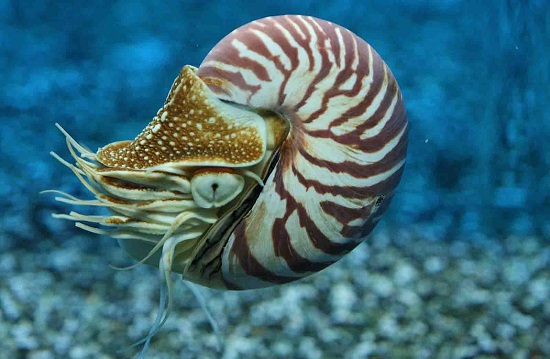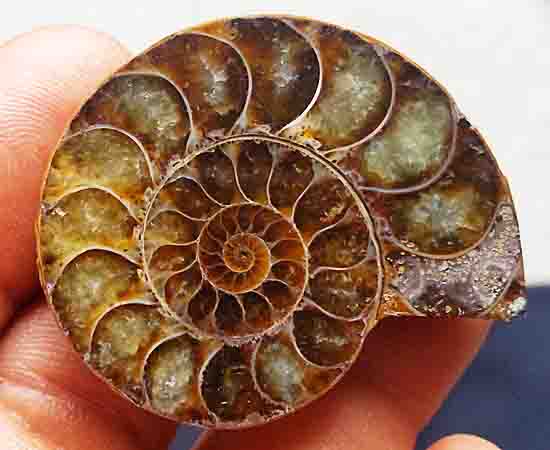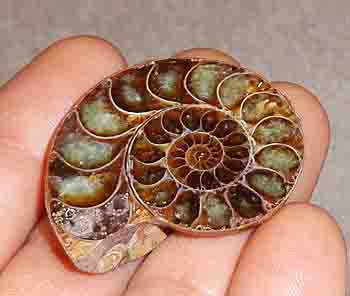I found a small ammonite fossil at a flea market and bought it on impulse.The type of ammonite I purchased was Cleoniceras sp. Cleoniceras sp is a type of ammonite that lived in the mid-Cretaceous period (approximately 140 million to 60 million years ago) and is native to Madagascar.Ammonite from Madagascar emits a strong red flash (fire) and has opal-like play of color, so it is expensive, but the ammonite I purchased was inexpensive because it did not have a red flash.
フリーマーケットでアンモナイトの小さな化石を見つけ衝動買いしました。購入したアンモナイトの種類は Cleoniceras spクレオニセラス属でした。Cleoniceras spは白亜紀中期(約1億4千万〜6千万年前)に生息していたアンモナイトの一種でマダガスカル産です。マダガスカル産は強い赤色の閃光(ファイヤー)を放ち、オパールのような遊色が浮き出るため高価ですが、購入したアンモナイトは赤色の閃光がないので安価でした。

Ammonites are extinct
A closely related species, the nautilus, lived during the Mesozoic era. Ammonites and nautiluses have almost the same body structure, and fossils are often found together, and both nautiluses and ammonites originally lived in shallow seas.
In the shallow sea, where there are many organisms, the slow-moving nautilus lost the struggle for survival and was forced into the deep sea.
Even today, the nautilus’ habitat is in the South Pacific at depths of 100 to 600 meters.Ammonites, able to move quickly, remained in shallow waters and were able to reproduce in more than 10,000 species.
アンモナイトは絶滅
中生代に近縁種のオウムガイが生息していました。アンモナイトとオウムガイは体の構造はほぼ同じで化石が一緒に発見されることも多く、元々はオウムガイもアンモナイトも浅い海に生息していました。生物の多い浅い海では、動きの遅いオウムガイは生存競争に敗れ、深海へと追いやられました。
現在でもオウムガイの生息地は南太平洋の水深100~600mほどの場所です。素早く動くことができたアンモナイトは浅い海に残り,1万種以上の繁殖に成功しました。

However, suddenly, 65.5 million years ago, an asteroid collided with the Earth, causing the Earth to cool down rapidly. During this period, the earth’s natural environment changed significantly, and many living things, including dinosaurs, became extinct in large numbers.
At this time, ammonites, which were directly affected by climate change, went extinct, while nautiluses, which were in the deep sea, escaped the effects and are thought to have survived to this day.
Although the nautilus was defeated in its struggle for survival, it was able to survive to the present day by moving to a different environment. The secret to survival is not strength, but adaptability to the environment.
しかし突然6550万年前、地球へ小惑星が衝突し、地球は急激に冷やされました。この時期に地球の自然環境は大きく変わり、恐竜を含めた多くの生物が大量に絶滅しました。
この時、気候変動の影響を直接受けたアンモナイトは絶滅、一方オウムガイは深海にいたため影響を免れ、現在まで生き残ったと考えられています。
オウムガイは生存競争に破れましたが、別の環境に移動するこで現在まで生き残ることが出来ました。強さではなく環境に適合することが生き残る秘訣ですね。

Fossil ammonite becomes calcite
The shell of purchased ammonite is cut in the middle so that the cross section is clearly visible. Each room separated by an ammonite wall is called an “air chamber.” It is thought that ammonites filled the air chambers with gas and liquid and adjusted their buoyancy by changing the balance of gas and liquid in the air chambers. The white part filling the inside of each air chamber in the photo is calcite. Calcite is a type of mineral made of crystallized calcium carbonate. After death, the calcium carbonate contained in the water surrounding the buried ammonite slowly crystallized and grew, filling the air chambers and becoming jewel-like. Ammonite is also valuable as a gemstone.
購入したアンモナイトは殻を中央部で切断され、断面がきれいに見えます。アンモナイトの離壁で仕切られた一つひとつの部屋は「気室」と呼ばれます。気室では、アンモナイトは気室ガスと液体で満たし、気室のガスと液体のバランスを変えることで、浮力を調整していたと考えれます。写真の各気室の内部を埋めている白い部分はカルサイトです。カルサイトは炭酸カルシウムが結晶化した鉱物の一種で、方解石とも呼ばれるます。死後、埋没したアンモナイトの周囲にあった水に含まれる炭酸カルシウムが、ゆっくりと結晶化して成長し、気室を埋めていき、宝石のようになりました。アンモナイトは宝石としても価値もあります。

![[商品価格に関しましては、リンクが作成された時点と現時点で情報が変更されている場合がございます。] [商品価格に関しましては、リンクが作成された時点と現時点で情報が変更されている場合がございます。]](https://hbb.afl.rakuten.co.jp/hgb/34abcec9.92fe015b.34abceca.0a1aba71/?me_id=1303261&item_id=10025189&pc=https%3A%2F%2Fthumbnail.image.rakuten.co.jp%2F%400_mall%2Fpowerstone-lulu%2Fcabinet%2Fsyou_pic59%2Fa40916-1_700.jpg%3F_ex%3D300x300&s=300x300&t=picttext)





コメント